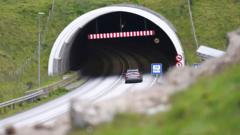The potential development of undersea tunnels in the Shetland Isles has garnered attention following remarks from the Faroese Prime Minister, Aksel Johannesen, who confidently stated that such infrastructure improvements could significantly boost local growth and rejuvenate island life. Shetland Islands Council is actively pursuing plans for this transformative project, which would connect four outer isles, including Unst, the furthest north inhabited island in the UK.
Johannesen highlighted the Faroese experience, where consistent investments in tunnels have enhanced both population and economic growth. He emphasized that effective infrastructure fosters opportunity and accessibility, contrary to the stagnation caused by reliance on aging ferry systems. The proposed Shetland project, funded through borrowing and toll collections, seeks to create a sustainable transport model that could serve as a blueprint for other Scottish islands.
Industry stakeholders, including Anne Anderson from Scottish Sea Farms, have voiced frustrations over the lack of timely infrastructure improvements in Scotland, pointing to the Faroes as a prime example of timely action. "We need to emulate what’s been done there," Anderson asserted, reflecting a widely held sentiment that Shetland must evolve to maintain its competitive edge in the global market, particularly in the lucrative salmon industry.
Tunnel construction in the Faroe Islands, which dates back to the 1960s, has connected the archipelago with 23 tunnels, including the world’s only underwater roundabout. This expansion has not only improved infrastructure but also emboldened residents to stay in smaller settlements while accessing central job markets seamlessly.
Andy Sloan, an engineer involved in tunnels' construction in the Faroes, concurs that Shetland can replicate this success, citing the tunnel-building technique already used in the Faroese projects. The islands’ significant achievements in connectivity underscore the necessity of integrating robust infrastructure into the Shetland economy.
Shetland’s council leader, Emma Macdonald, underscored the potential transformational aspect of this initiative, which is seen as crucial for revitalizing the region’s economy and facilitating the transition towards renewable energy following the oil and gas boom. The ongoing feasibility study, which has received a budget of £990,000, seeks to explore practicalities for constructing tunnels to Unst, Yell, Bressay, and Whalsay.
Despite underlying concerns about changes to island life, some residents, including local shop owner Pat Burns, are already re-evaluating their opposition, citing practical advantages of improved transportation over potential alterations to their way of life. The prevailing attitude among community members appears to lean toward accepting tolls for the tunnels, as they recognize the pressing need for enhanced transport solutions.
As local leaders plot their path forward, the focus remains steadfast on fostering a forward-thinking community that acknowledges its regional significance while aligning with long-term sustainability goals. Embracing tunnel infrastructure, inspired by the Faroese model, positions Shetland as a key player in the broader Scottish economy through innovative transport solutions.




















